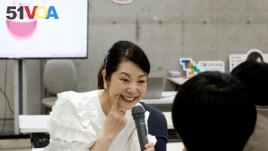06 June 2023
In one of Keiko Kawano's recent classes, more than 10 Tokyo art school students held mirrors to their faces. The students moved the sides of their mouths upward with their fingers. They were practicing how to smile.
Kawano's services as a smile teacher are seeing increased demand in Japan, where almost everyone wore face coverings such as masks during the pandemic.
Himawari Yoshida is taking the class as part of a school program that prepares students for the job market. The 20-year-old Yoshida said she needed to work on her smile.

FILE - Smile coach Keiko Kawano teaches students at a smile training course at Sokei Art School in Tokyo, Japan, May 30, 2023. REUTERS/Kim Kyung-Hoon
"I hadn't used my facial muscles much during COVID, so it's good exercise," she said.
Kawano's company, Egaoiku, which means "smile education," has customers that include private companies and local governments. An hour-long one-on-one lesson costs $55.
Mask-wearing was normal in Japan even before the pandemic. People wear masks when it is allergy season and around school test times.
While the government may have lifted its recommendation to wear masks in March, many people have not stopped wearing them. An opinion study by public broadcaster NHK in May showed 55 percent of Japanese say they were wearing masks just as often as two months earlier. Only eight percent said they had stopped wearing masks.
Around 25 percent of the art school students who took the class kept their masks on during the class. Young people might have become used to life with masks, Kawano said. She noted that women might find it easier to go out without makeup and men can hide that they have not cut their facial hair.
Kawano is a former radio host. She started giving lessons in 2017.
She has also trained 23 others as smiling coaches to spread the method of creating a good smile.
Her "Hollywood Style Smiling Technique" method includes "crescent eyes," "round cheeks" and shaping the edges of the mouth to show eight teeth in the upper row. Students can try out their technique on a tablet to get scored on their smile.
Kawano believes that, culturally, Japanese people may be less likely to smile than Westerners. The difference could be a result of Japan's sense of security as an island nation and as a state. Reuters news service said Kawano wondered if the threat of guns might cause people to smile more.
"Culturally, a smile signifies that I'm not holding a gun and I'm not a threat to you," she said.
An increasing number of foreign visitors have been coming to Japan. Kawano said that Japanese people need to communicate with foreigners with more than just their eyes:
She said, "I think there's a growing need for people to smile."
I'm John Russell.
Anton Bridge and Tom Bateman reported on this story for Reuters. John Russell adapted it for VOA Learning English.
_______________________________________
Words in This Story
mirror – n. a piece of glass that reflects images
practice –v. to do something again and again in order to become better at it
muscles –n. the parts of the body that create movement
customer –n. a person, company or group that pays for goods or services
allergy season –n. periods during the year when there are high levels of plant pollen or mold spores in the air which cause a bad reaction for people who are sensitive to such things
crescent – n. a shape that is curved and pointed at its two ends like a crescent moon
tablet – n. a flat, rectangular computing device
signify – v. to mean (something)